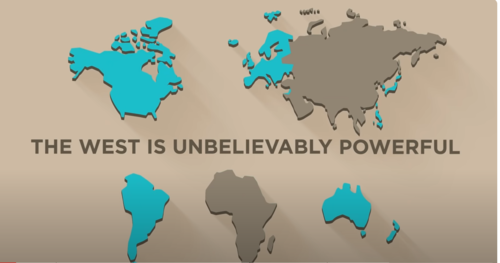Difference between revisions of "Essay: Why has the West been so successful?"
Conservative (Talk | contribs) (→Non-Westerners in China and Russia are voting with their feet: Many Chinese and Russians are leaving their countries) |
Conservative (Talk | contribs) (→General) |
||
| Line 127: | Line 127: | ||
*[[Essay: Why did so many self-declared international relations experts miserably fail concerning their multipolar fantasy?|Why did so many self-declared international relations experts miserably fail concerning their multipolar fantasy?]] | *[[Essay: Why did so many self-declared international relations experts miserably fail concerning their multipolar fantasy?|Why did so many self-declared international relations experts miserably fail concerning their multipolar fantasy?]] | ||
*[[Essay: What drives Xi Jinping and Vladimir Putin?|What drives Xi Jinping and Vladimir Putin?]] | *[[Essay: What drives Xi Jinping and Vladimir Putin?|What drives Xi Jinping and Vladimir Putin?]] | ||
| − | |||
*[[Essay: Slow and steady growth over the long term via capitalism and the rule of law versus short-sighted authoritarian economic growth that is costly to the long term economy|Slow and steady growth over the long term via capitalism and the rule of law versus short-sighted authoritarian economic growth that is costly to the long term economy]] | *[[Essay: Slow and steady growth over the long term via capitalism and the rule of law versus short-sighted authoritarian economic growth that is costly to the long term economy|Slow and steady growth over the long term via capitalism and the rule of law versus short-sighted authoritarian economic growth that is costly to the long term economy]] | ||
*[[Essay: Attention anti-American hyper Russophiles/Sinophiles. Time is not on your side|Attention anti-American hyper Russophiles/Sinophiles. Time is not on your side]] | *[[Essay: Attention anti-American hyper Russophiles/Sinophiles. Time is not on your side|Attention anti-American hyper Russophiles/Sinophiles. Time is not on your side]] | ||
Revision as of 19:36, May 12, 2024

There are countries in Asia that have adopted much of Western values such as Japan, South Korea and the Philippines.
The above graphic comes from the video Why the West Won’t Collapse with Stephen Kotkin (Stephen Kotkin is an American historian, academic, and author.)
Question: Are there very positive aspects of Western Civilization? If so, what are they?
The West:
- Why the West Won’t Collapse with Stephen Kotkin (Stephen Kotkin is an American historian, academic, and author.)
Western values:
- China and Russia Are Giving Authoritarianism a Bad Name, April 18, 2022
Contents
- 1 Western missionaries and the good things that they helped create in the world. Also, Christianity and social stability
- 2 Non-Westerners in China and Russia are voting with their feet: Many Chinese and Russians are leaving their countries
- 3 High income countries are rarely authoritarian countries
- 4 Decline of the West
- 5 User: Conservative's geopolitics essays
- 6 References
Western missionaries and the good things that they helped create in the world. Also, Christianity and social stability

See also: Christianity and social stability
The article The Surprising Discovery About Those Colonialist, Proselytizing Missionaries published in Christianity Today notes:
| “ | In his fifth year of graduate school, Woodberry created a statistical model that could test the connection between missionary work and the health of nations. He and a few research assistants spent two years coding data and refining their methods. They hoped to compute the lasting effect of missionaries, on average, worldwide...
One morning, in a windowless, dusty computer lab lit by fluorescent bulbs, Woodberry ran the first big test. After he finished prepping the statistical program on his computer, he clicked "Enter" and then leaned forward to read the results. "I was shocked," says Woodberry. "It was like an atomic bomb. The impact of missions on global democracy was huge. I kept adding variables to the model—factors that people had been studying and writing about for the past 40 years—and they all got wiped out. It was amazing. I knew, then, I was on to something really important." Woodberry already had historical proof that missionaries had educated women and the poor, promoted widespread printing, led nationalist movements that empowered ordinary citizens, and fueled other key elements of democracy. Now the statistics were backing it up: Missionaries weren't just part of the picture. They were central to it... Areas where Protestant missionaries had a significant presence in the past are on average more economically developed today, with comparatively better health, lower infant mortality, lower corruption, greater literacy, higher educational attainment (especially for women), and more robust membership in nongovernmental associations. In short: Want a blossoming democracy today? The solution is simple—if you have a time machine: Send a 19th-century missionary... ...at a conference presentation in 2002, Woodberry got a break. In the room sat Charles Harper Jr., then a vice president at the John Templeton Foundation, which was actively funding research on religion and social change. (Its grant recipients have included Christianity Today.) Three years later, Woodberry received half a million dollars from the foundation's Spiritual Capital Project, hired almost 50 research assistants, and set up a huge database project at the University of Texas, where he had taken a position in the sociology department. The team spent years amassing more statistical data and doing more historical analyses, further confirming his theory. ...Woodberry's historical and statistical work has finally captured glowing attention. A summation of his 14 years of research—published in 2012 in the American Political Science Review, the discipline's top journal—has won four major awards, including the prestigious Luebbert Article Award for best article in comparative politics. Its startling title: "The Missionary Roots of Liberal Democracy." ...over a dozen studies have confirmed Woodberry's findings. The growing body of research is beginning to change the way scholars, aid workers, and economists think about democracy and development.[2] |
” |
David Beidel wrote in his article The Bloodless Revolution: What We Need to Learn from John Wesley and the Great Awakening
| “ | In the 18th Century, most of Europe was on fire. Bloody civil wars and revolutions were decimating nation after nation. Unrestrained injustice, government and Church corruption, slave trade and the oppression of the poor created a powder keg for violence. Miraculously, Great Britain escaped the horrors of civil war and the brutal savagery that revolutionary anarchy engenders.
Few ancient monarchies are still in place today. The mystery of the UK’s capacity to honor the old guard, while raising up a more democratic system without a revolution, is a sociological wonder. Many credit the Great Awakening, in particular the Methodist movement, launched by John Wesley, for this extraordinary and peaceful transition. Methodism unleashed an army of “little Christ’s” all over Europe. They cared for the poor, took in unwanted and abused children, fought unjust laws and labor conditions, visited prisoners, and battled against slavery; They joined hands with the Apostles and “turned the world upside down.” Eventually compassion became fashionable... America is in desperate need of a Christ-infused revolution of compassion. We are a land of churches, who are well positioned to hear and answer the cries of our struggling communities. If a critical mass of congregations committed themselves to radically sharing the Gospel and passionately serving under-resourced/at-risk communities, we will see peace powerfully rise in these times of trouble. This will also enable, as in the days of John Wesley, wise reformation to take place because the true Christian Church is theologically hardwired to bring about peaceful, meaningful change that benefits all. I have written much about this in my book, Samaria, The Great Omission, and treasure every opportunity to strategize with churches who have a heart to minister in this way. Let us stand in the gap as cultural/community peacemakers and healers in this season of sorrow and division. May our magnificent obsession be Jesus, the everlasting, ever loving, rescuer of the oppressed and Father of all.[3] |
” |
Non-Westerners in China and Russia are voting with their feet: Many Chinese and Russians are leaving their countries
Chinese emigration from China:
- China is experiencing a brain drain and more people are fleeing China (See: China’s Brain Drain Threatens Its Future, Wall Street Journal, 2023)
- As economy falters, more Chinese migrants take a perilous journey to the US border to seek asylum, Associated Press, 2023
Russian emigration from Russia:
Russia is experiencing a large brain drain
- Russia's massive brain drain is ravaging the economy - these stunning figures show why it will soon be smaller than Indonesia's, Business Insider, September 2023
- Russia's economy faces a 'massive brain drain' as over 1 million young workers exit labor force, Markets Insider, 2023
- The Great Russian Brain Drain, Novaya Gazeta Europe, 2023
- As Russia sees tech brain drain, other nations hope to gain, Associated Press, 2022
High income countries are rarely authoritarian countries
See: High income countries are rarely authoritarian countries
Decline of the West
Although Western Civilization definitely has its strengths, the West has experienced some decline as can be seen by the resources below:
- Post 1950s, the USA has experienced some decline (Divorce rate increase, increase in fatherless homes, high federal government debt, the sexual revolution, etc.).
Hope for the United States adopting more social conservatism and becoming more religious in the future
See also: United States, irreligion vs. religion and demographics
On July 24, 2019, due to religious immigration to the United States and the higher fertility rate of religious people, Eric Kaufmann wrote in an article entitled Why Is Secularization Likely to Stall in America by 2050? A Response to Laurie DeRose: "Overall, the picture suggests that the U.S. will continue to secularize in the coming decades. However, a combination of religious immigration, immigrant religious retention, slowing religious decline due to a rising prevalence of believers among the affiliated, and higher native religious birth rates will result in a plateauing of secularizing trends by mid-century." [4]
Steve Turley wrote:
| “ | According to University of London scholar Eric Kaufmann’s detailed study on global demographic trends, we are in the early stages of nothing less than a demographic revolution. In Kaufmann’s words, "religious fundamentalists are on course to take over the world." There is a significant demographic deficit between secularists and conservative religionists. For example, in the U.S., while self-identified non-religionist women averaged only 1.5 children per couple in 2002, conservative evangelical women averaged 2.5 children, representing a 28 percent fertility edge. Kaufmann notes that this demographic deficit has dramatic effects over time. In a population evenly divided, these numbers indicate that conservative evangelicals would increase from 50 to 62.5 percent of the population in a single generation. In two generations, their number would increase to 73.5 percent, and over the course of 200 years, they would represent 99.4 percent. The Amish and Mormons provide contemporary illustrations of the compound effect of endogamous growth. The Amish double in population every twenty years, and projections have the Amish numbering over a million in the U.S. and Canada in just a few decades. Since 1830, Mormon growth has averaged 40 percent per decade, which means that by 2080, there may be as many as 267 million Mormons in the world, making them by 2100 anywhere from one to six percent of the world’s population.
In Europe, immigration is making the continent more religiously conservative, not less; in fact, London and Paris are some of the most religiously dense areas within their respective populations. In Britain, for example, Ultra-Orthodox or Haredi Jews constitute only 17 percent of the Jewish population but account for 75 percent of Jewish births. And in Israel, Haredi schoolchildren have gone from comprising a few percent to nearly a third of all Jewish pupils in a matter of five decades, and are poised to represent the majority of the Jewish population by 2050. Since 1970, charismatic Christians in Europe have expanded steadily at a rate of 4 percent per year, in step with Muslim growth. Currently, Laestadian Lutherans in Finland and Holland’s Orthodox Calvinists have a fertility advantage over their wider secular populations of 4:1 and 2:1 respectively. In contrast, Kaufmann’s data projects that secularists, who consistently exemplify a low fertility rate of around 1.5 (significantly below the replacement level of 2.1), will begin a steady decline after 2030 to a mere 14 to 15 percent of the American population. Similar projections apply to Europe as well. Kaufmann thus appears to have identified what he calls "the soft underbelly of secularism," namely, demography. This is because secular liberalism entails its own “demographic contradiction,” the affirmation of the sovereign individual devoid of the restraints of classical moral structures necessitates the freedom not to reproduce. The link between sex and procreation having been broken, modernist reproduction translates into mere personal preference. It thus turns out that the radical individualism so celebrated and revered by contemporary secular propagandists is in fact the agent by which their ideology implodes.[5] |
” |
Hope for Europe slowing down or reversing its decline
User: Conservative's geopolitics essays
General
- The myth of multipolarity. What do the terms unipolar, bipolar and multipolar mean as far as international relations?
- Why did so many self-declared international relations experts miserably fail concerning their multipolar fantasy?
- What drives Xi Jinping and Vladimir Putin?
- Slow and steady growth over the long term via capitalism and the rule of law versus short-sighted authoritarian economic growth that is costly to the long term economy
- Attention anti-American hyper Russophiles/Sinophiles. Time is not on your side
- The 2023 BRICS Summit was a bunch of hoopla. We still don't live in a multipolar world.
- The wreck of the HMS Multipolar World Fantasy - Humor
- The anti-Christianity Mao Zedong, Fidel Castro, Joseph Stalin and Xi Jinping have opposed homosexuality so this isn't a very high moral bar for China and Russia to clear
The United States
- The United States will be the leading power in the world for the foreseeable future
- Is the USA an economic powerhouse and juggernaut?
China
Russia
War in Ukraine
- The SPECIFIC MONTH OF APRIL 2022 was not a pivotal point in politics that will affect politics for 30 years (A Minor dispute with a Conservapedian about the war in Ukraine)
Give me liberty, or give me death!

References
- ↑ The Christian origin of hospitals
- ↑ Christianity Today, The Surprising Discovery About Those Colonialist, Proselytizing Missionaries, January 8, 2014
- ↑ The Bloodless Revolution: What We Need to Learn from John Wesley and the Great Awakening by David Beidel
- ↑ Why Is Secularization Likely to Stall in America by 2050? A Response to Laurie DeRose by Eric Kaufmann July 24, 2019
- ↑ (source: Text below the YouTube video Shall the Religious Inherit the Earth and the text was written by Dr. Steven Turley).


